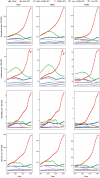Global, regional, and national trends and burden of opioid use disorder in individuals aged 15 years and above: 1990 to 2021 and projections to 2040
- PMID: 40511691
- PMCID: PMC12175101
- DOI: 10.1017/S2045796025100085
Global, regional, and national trends and burden of opioid use disorder in individuals aged 15 years and above: 1990 to 2021 and projections to 2040
Abstract
Aim: Opioid use disorder (OUD) is a medical condition associated with problematic opioid use, leading to addiction and severe life impairments. This research delivers an in-depth evaluation of OUD burden and trends at global, regional and national levels.
Methods: This study analysed the global burden of OUD from 1990 to 2021 using data from the 2021 Global Burden of Diseases, Injuries, and Risk Factors Study. Key metrics included age-standardized prevalence, incidence, mortality and disability-adjusted life years (DALYs), disaggregated by gender, age, region, country and socio-demographic index (SDI) quintiles. The average annual percentage change described trends, while the age-period-cohort model evaluated age, period and cohort effects. A Bayesian Age-period-cohort model predicted future OUD trends from 2022 to 2040.
Results: In 2021, the global burden of OUD remained substantial, with a total of 16,164,876 cases and a prevalence of 154.59 cases per 100,000 population (95% uncertainty interval [UI]: 131.06-181.26). In 2021, the global incidence of OUD reached 1,942,525 cases (95% UI: 1,643,342-2,328,363), and its global mortality reached 99,555 deaths (95% UI: 92,948-108,050), with DALYs amounting to 11,218,519 (95% UI: 9,188,658-13,159,551). Regionally, high SDI regions, particularly in the High-income North America, exhibited the greatest burden. Among countries, the United States faced the most severe burden and increase, with the highest prevalence (2014.62 per 100,000), incidence (151.84 per 100,000), mortality (15.37 per 100,000) and DALYs (1594.63 per 100,000), and all APPC values exceeding 5%. Males aged 20-39 years were the most affected demographic. However, forecasts indicate that the OUD burden among females will significantly increase over the next 20 years, with the prevalence and incidence expected to rise by 39% and 49%, respectively.
Conclusions: The global burden of OUD has statistically significantly increased from 1990 to 2021. There are marked disparities across regions, countries and SDI levels. High-SDI regions, particularly High-income North America, bear the heaviest burden, with young males (aged 20-39 years) being the most affected groups. However, caution should be exercised regarding the female population, as the number of affected individuals is rapidly increasing.
Keywords: disability-adjusted life years; epidemiology; global burden of disease; opioid use disorder; prevalence.
Conflict of interest statement
The authors declare no conflict of interest.
Figures





Similar articles
-
Burden of knee osteoarthritis in China and globally: 1990-2045.BMC Musculoskelet Disord. 2025 Jul 1;26(1):582. doi: 10.1186/s12891-025-08858-8. BMC Musculoskelet Disord. 2025. PMID: 40598022 Free PMC article.
-
Global, regional, and national burden of maternal disorders, 1990-2021: a systematic analysis from the global burden of disease study 2021.BMC Public Health. 2025 Jul 29;25(1):2576. doi: 10.1186/s12889-025-23814-w. BMC Public Health. 2025. PMID: 40730990 Free PMC article.
-
Global trends in the burden of alcohol use disorders in the working-age population from 1990 to 2021 and projections for the next 20 years.Front Public Health. 2025 Jul 28;13:1616343. doi: 10.3389/fpubh.2025.1616343. eCollection 2025. Front Public Health. 2025. PMID: 40791621 Free PMC article.
-
Burden of inflammatory bowel disease among elderly, 1990-2019: A systematic analysis based on the global burden of disease study 2019.Autoimmun Rev. 2025 Jan 31;24(2):103708. doi: 10.1016/j.autrev.2024.103708. Epub 2024 Nov 23. Autoimmun Rev. 2025. PMID: 39586389
-
Global burden and risk factors of musculoskeletal disorders among adolescents and young adults in 204 countries and territories, 1990-2019.Autoimmun Rev. 2023 Aug;22(8):103361. doi: 10.1016/j.autrev.2023.103361. Epub 2023 May 23. Autoimmun Rev. 2023. PMID: 37230312 Review.
References
-
- American Psychiatric Association (2013). Diagnostic and Statistical Manual of Mental Disorders: DSM-5. vol. 5 Washington, DC: American Psychiatric Association.
-
- Bergeria CL and Strain EC (2022). Opioid use disorder: pernicious and Persistent. The American Journal of Psychiatry 179(10), 708–714. - PubMed
-
- Bounthavong M and Yip O (2024). Association between county-level social vulnerability and deprivation with opioid dispensing rates in the United States. International Journal of Mental Health and Addiction 1–21. doi: 10.1007/s11469-024-01310-3 - DOI
-
- Castaldelli-Maia JM, Wang YP, Brunoni AR, Faro A, Guimarães RA, Lucchetti G, Martorell M, Moreira RS, Pacheco-Barrios K, Rodriguez JAB, Roever L, Silva DAS, Tovani-Palone MR, Valdez PR, Zimmermann IR, Culbreth GT, Hay SI, Murray CJL and Bensenor IM (2023). Burden of disease due to amphetamines, cannabis, cocaine, and opioid use disorders in South America, 1990-2019: a systematic analysis of the Global Burden of Disease Study 2019. The Lancet Psychiatry 10(2), 85–97. - PMC - PubMed
MeSH terms
LinkOut - more resources
Full Text Sources
Medical

